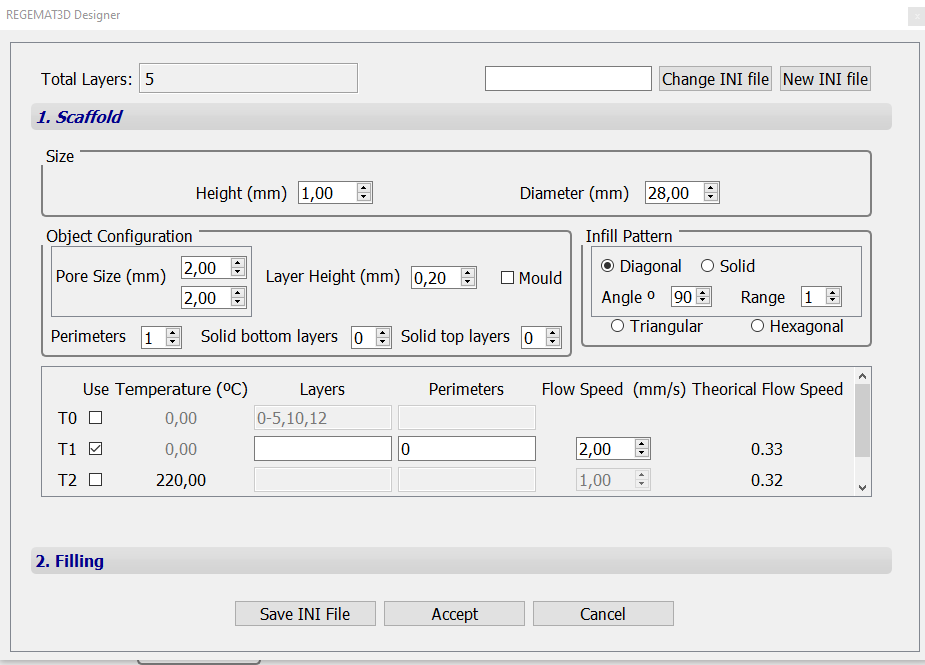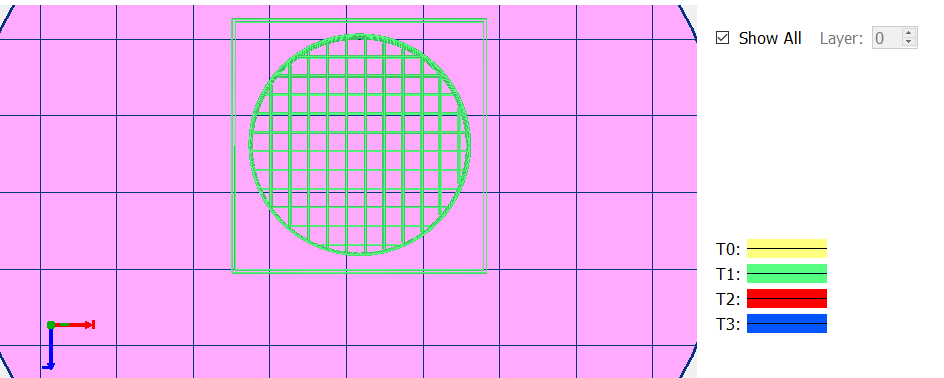INTRODUCTION
Type I collagen is the most abundant type of collagen in the human body, as a major structural matrix protein in skin and many other tissues including bone, tendon and fibrous connective tissues.
ColBioink is a sterile solution of highly purified collagen type I from porcine origin that can be used either straightaway to print 3D scaffolds or being loaded with suspended cells to print cell-laden structures. The wide range of collagen concentration allows researchers to produce designs with different mechanical densities and rates of bioresorption depending on their biomedical purpose and the type of cells being used – fibroblasts, multipotent mesenchymal stromal cells, etc-.
ColBioink is printable either at lower temperatures (4ºC-10ºC) or at RT. Given that collagen is one of the most abundant structural proteins of the extracellular matrix of many tissues within the body, the high viability and cellular functions of encapsulated cells are ensured in long term cultures with ColBioink. Its high content in atelocollagen ensures low immunogenicity.
This protocol describes the materials, equipment and the steps required for the direct 3D bioprinting of ColBioink cell-laden scaffolds.
MATERIALS
Reagents and consumables
- ColBioink kit including: 1 ml of sterile ColBioink (80 mg/ml) loaded in a syringe; one vial containing 0.5 ml of sterile neutralization solution; two sterile 5 ml syringes with needle and a sterile luer connector
- 5 cc bioprinting syringe
- 5 cc red adjustment piston
- 22G conical dispensing tips
- Cells
- Complete cell culture media
- 1X Phosphate-Buffered Saline (1X PBS)
- Trypsin/EDTA solution
- Culture dish
- Serological pipettes
- Tips for micorpipette
- Live/Dead viability/cytotoxicity kit
- Trypan blue solution
Equipment required
- REG4Life 3D bioprinter
- Class 100 laminar flow cabinet
- Biosafety cabinet
- Cell culture incubator
- Centrifuge
- Micropipette
- Pipetor
- Hemocytometer
METHODS
Prior to 3D bioprinting, ColBioink must be neutralized by mixing with a buffered solution. Recommended ColBioink working concentrations for extrusion-based 3D bioprinting range between 30-40 mg/ml. All steps must be performed inside a laminar flow cabinet, using sterile materials/reagents and following aseptic techniques. Collagen solution must be kept between 4-8°C. It is preferable to maintain the temperature of the bioink between 4-10ºC during the bioprinting process, while heating the printing platform to 37ºC in order to start the immediate collagen polymerization for best fidelity results.
- Neutralization of collagen solution:
- Connect the needle to a 5 ml syringe and aspirate 0.5 ml of the buffer for neutralization from the vial
- Remove the needle and place a sterile connector onto the tip of the syringe
- Slowly push plunger in until the solution forms a small droplet at the end of the connector on the syringe
- Remove cap from the syringe containing ColBioink solution and slowly push plunger in until the collagen forms a small droplet at the tip of the syringe
- Connect the syringe with the buffer for neutralization to the syringe containing ColBioink solution. Ensure that there are no air bubbles
- Intensely push plunger back and forth up to 50 times for thorough mixing
- Disconnect syringes saving the connector on the syringe with the mixture
- The neutralized collagen is now ready for mixing with cells
- Preparation of bioink
- Harvest cells, count them in a hemocytometer, centrifuge and resuspend pellet in complete cell culture media (0.5 – 1 ml). Adjust cell density within recommended range (0.1-1×106 cells/ml bioink)
- Connect a needle to a new 5 ml syringe and fill it with the cell suspension
- Remove cap from the syringe and slowly push plunger in until a small droplet forms at the tip of the syringe
- Take the syringe containing neutralized ColBioink (step 1.8)
- Slowly push the plunger in until the neutralized collagen forms a small droplet at the end of the coupler on the syringe
- Connect the syringe with cells to the syringe with neutralized ColBioink. Ensure that there are no air bubbles
- Slowly push plunger back and forth up to 50 times or until a homogeneous mixture is observed
- Disconnect syringes ensuring that the connector is on the syringe containing the bioink
- Transfer the bioink to a 5 cc syringe containing a 5 cc adjustment piston, compatible with the REG4Life bioprinter (REGEMAT 3D). The bioink is now ready for 3D bioprinting
- Harvest cells, count them in a hemocytometer, centrifuge and resuspend pellet in complete cell culture media (0.5 – 1 ml). Adjust cell density within recommended range (0.1-1×106 cells/ml bioink)
- 3D bioprinting of ColBioink cell-lladen scaffolds:
- Turn on the laminar flow cabinet, switch on the REG4Life bioprinter and launch REGEMAT 3D Designer Software (REGEMAT 3D)
- Connect the syringe containing the cell-laden bioink to a 22G ID conical dispensing tip and place it in the printhead. If printing is performed at lower temperatures, make a precool the printhead down to 4-10ºC
- Proceed with the laser calibration by choosing the corresponding tool/printhead in “Header Configuration” and by clicking “Calibration” in the REGEMAT 3D Designer Software. Ensure that the glass bed is installed on the printing platform
- Remove the glass bed, insert the petri dish into its adaptor and then secure it on the printing platform. Adjust the distance between the tip of the syringe and the surface of the printing bed to approx. 0.30 mm by clicking “Header Configuration” and “Fine Calibration”
- Once the bioprinter is calibrated, proceed with the generation of 3D constructs by loading the desired .stl file or Gcode.
- Add enough cell culture media to cover the entire construct and keep in a cell culture incubator at 37ºC and 5% CO2.
The following bioprinting parameters have been optimized for generating porous cylindrical ColBioink scaffolds containing human adipose-derived mesenchymal stem cells at a density of 7.5×105 cells/ml of bioink and at a concentration of 30 mg/ml collagen.
Object configuration
Extra configuration
Printable object
RESULTS

Figure 1. Macroscopic images of ColBioink 3D constructs with cylindrical porous (A) and tubular geometries (B). Scaffold from image A was generated using the printing parameters from the previous section.
Biocompatibility assay
Figure 2. Representative confocal microscopy images of 3D bioprinted constructs of encapsulated human adipose-derived mesenchymal stem cells in ColBioInk after several weeks in culture, showing live (green, stained with calcein) and dead (red, stained with ethidium homodimer-I) cells, with cell nuclei stained with Hoechst 33342 (blue). Detailed protocol for Live/Dead+Hoechst staining can be found in the labmethod “Scaffold biocompatibility assessment”.
| Number | Category | Product | Amount |
|---|





